THE HISTORY OF THE WHITE SHIRT
1830s-1850s
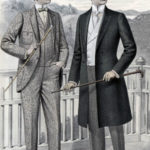
Often seen as utilitarian and unisex, the white dress shirt underwent a transformation during the Victorian era. At this time, those wearing a dress shirt were seen as wealthy and of the upper class – even though the dress shirt was usually covered by vests and coats.
1830s-1850s1850s
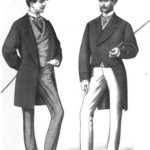
Crisp white dress shirts were the sign of someone who could afford the finer things – changing dress shirts regularly meant you had more than one and had them frequently and professionally washed in order to maintain that bright, clean white look. This is where the term ‘white collar’ and ‘blue collar’ originated. Blue collar represented the working class, while the white dress shirt highlighted affluence and status.
1850s1880s
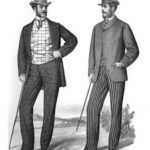
1880s Starched white collars also became a status symbol. The higher the collar, the more elite one was perceived – after all, low collars meant easier movement for everyday workers like clerks or other office professionals. At the turn of the century, wearing a white shirt without the status of affluence (such as a clerk wearing one as part of daily garb) caused some resentment amongst the working class – it gave off the appearance that one was dressing above their social standing and they were given the nickname of a ‘white collar stiff.’
1880s1890-1900s
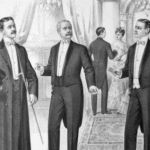
Affordability and increased production of the white dress shirt made it so that more men had access – which means it’s symbol of status was not as front and center. More men began wearing the dress shirt to work and church. The starched white color of the shirt was no longer the sole image of wealth and prosperity – instead, a beautifully tailored shirt with higher quality fabric and personalized style elevated those in higher social classes.
1890-1900s1920s
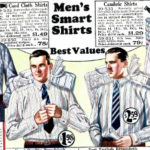
Still a respectable addition to a gentleman’s wardrobe, the white dress shirt lost the stiff and starched appearance for more of a softer look after World War I. Edward VIII, known as the Prince of Wales, opted for more flowy and soft shirts, creating a fashionable shift toward comfort and style. White dress shirts also became seen as an employee’s uniform – the once-classic look becoming mandatory in office environments.
1920s1970s

Through the previous decades, the look and style of the white dress shirt remained the same; however, synthetic fabrics replaced traditional fabrics for more comfort and versatility during the 1970s. Through the subsequent decades, more design aspects altered the look of the dress shirt to be on trend – such as ruffles or floppy details and accents.
1970s2018-Present

White dress shirts are still seen as professional attire, but a number of changes accommodate the fast-paced lifestyle of entrepreneurs. Wanting something a bit different than the starchy dress shirts of a previous generation, innovative entrepreneurs at H. White have put comfort, functionality and style to work in the new Corporate Combat hybrid dress shirt. Maintaining that quintessential crisp appearance while adding quality upgrades to the shirt is what transforms the traditional business garment into a wearable, comfortable style with features that include sweat-wicking fabrics and high-quality cotton for breathability and luxury on the go!
2018-Present
 BUY NOW
BUY NOW